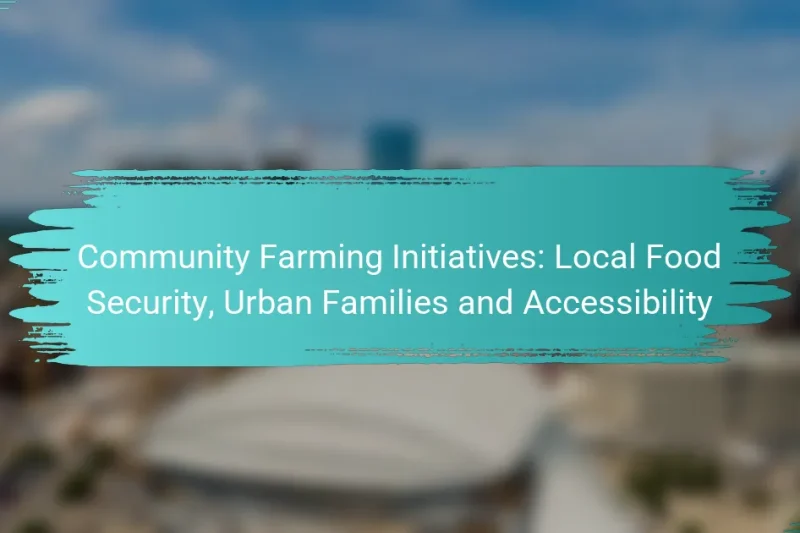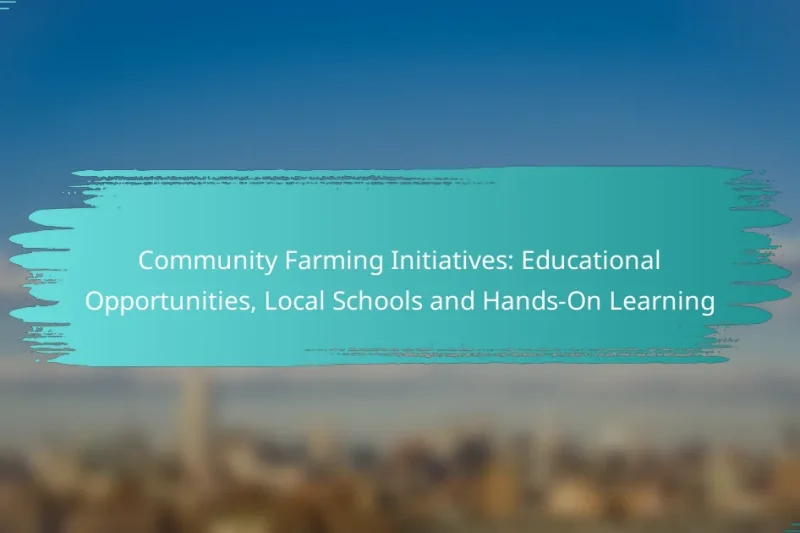Community farming initiatives play a crucial role in enhancing local food security for urban families by … Community Farming Initiatives: Local Food Security, Urban Families and AccessibilityRead more
Benefits of Community Farming Initiatives
Community farming initiatives offer a multitude of benefits that extend beyond just food production. They enhance access to fresh produce, strengthen social connections among residents, and contribute to environmental sustainability. By fostering collaboration and supporting local economies, these initiatives create healthier communities while promoting eco-friendly practices.
Community Farming Initiatives: Health Improvements, Nutrition and Physical Activity
Community farming initiatives play a vital role in enhancing health and well-being in urban areas by … Community Farming Initiatives: Health Improvements, Nutrition and Physical ActivityRead more
Community Farming Initiatives: Social Cohesion, Shared Projects and Community Engagement
Community farming initiatives play a vital role in enhancing social cohesion within urban areas by uniting … Community Farming Initiatives: Social Cohesion, Shared Projects and Community EngagementRead more
Community Farming Initiatives: Environmental Benefits, Urban Areas and Biodiversity
Community farming initiatives play a crucial role in enhancing urban environments by promoting sustainable agriculture and … Community Farming Initiatives: Environmental Benefits, Urban Areas and BiodiversityRead more
Community Farming Initiatives: Educational Opportunities, Local Schools and Hands-On Learning
Community farming initiatives serve as a vital resource for local schools, offering students hands-on learning experiences … Community Farming Initiatives: Educational Opportunities, Local Schools and Hands-On LearningRead more
Community Farming Initiatives: Economic Impact, Low-Income Neighborhoods and Job Creation
Community farming initiatives play a crucial role in transforming low-income neighborhoods by enhancing access to fresh … Community Farming Initiatives: Economic Impact, Low-Income Neighborhoods and Job CreationRead more
Community Farming Initiatives: Sustainable Practices, Environmental Impact and Community Resilience
Community farming initiatives play a crucial role in promoting sustainability by integrating environmentally friendly practices that … Community Farming Initiatives: Sustainable Practices, Environmental Impact and Community ResilienceRead more
What are the benefits of community farming initiatives in urban areas?
Community farming initiatives in urban areas provide numerous advantages, including increased access to fresh produce, strengthened social ties, and improved environmental conditions. These initiatives foster collaboration among residents, enhance local economies, and promote healthier lifestyles.
Improved food security
Community farming initiatives directly contribute to improved food security by increasing the availability of fresh fruits and vegetables in urban settings. By growing food locally, these projects reduce reliance on distant supply chains, ensuring that residents have access to nutritious options.
Additionally, community farms often focus on cultivating crops that are well-suited to the local climate, which can lead to higher yields and better food variety. This local production helps mitigate food deserts, where access to healthy food is limited.
Enhanced community engagement
Community farming initiatives foster enhanced community engagement by bringing people together for a common purpose. Participants often collaborate on planting, maintenance, and harvesting, which builds relationships and strengthens social networks.
These projects can also serve as educational platforms, where community members learn about sustainable agriculture, nutrition, and environmental stewardship, further deepening their connection to one another and their surroundings.
Environmental sustainability
Community farming promotes environmental sustainability by utilizing practices that enhance biodiversity and reduce carbon footprints. Urban farms often incorporate organic farming techniques, which minimize chemical use and improve soil health.
Moreover, these initiatives can help manage stormwater runoff and reduce urban heat through increased green spaces, contributing to a healthier urban ecosystem overall.
Economic development
Community farming initiatives can stimulate local economic development by creating jobs and supporting local businesses. These farms often source materials and supplies from nearby vendors, keeping money circulating within the community.
Additionally, they may offer products directly to consumers through farmers’ markets or community-supported agriculture (CSA) programs, providing residents with affordable access to fresh produce while generating income for the farmers.
Health and wellness promotion
Community farming initiatives promote health and wellness by encouraging physical activity and providing access to fresh, nutritious food. Engaging in farming activities can improve physical fitness and mental well-being, as participants often report feeling a sense of accomplishment and connection to nature.
Furthermore, these initiatives can serve as platforms for nutrition education, helping community members understand the benefits of healthy eating and how to prepare fresh produce, ultimately leading to healthier lifestyle choices.
How do community farming initiatives support local economies?
Community farming initiatives bolster local economies by creating jobs, supporting nearby businesses, and enhancing property values. These initiatives foster a sense of community while providing economic benefits that can be felt across various sectors.
Job creation
Community farming initiatives generate employment opportunities in various roles, from farm labor to management positions. These jobs often cater to a diverse workforce, including local residents and seasonal workers, contributing to lower unemployment rates in the area.
Moreover, the jobs created can range from full-time positions to part-time or volunteer roles, accommodating different community members’ needs and availability. This flexibility helps to engage more individuals in the local economy.
Support for local businesses
By sourcing supplies and services locally, community farms stimulate the growth of nearby businesses. This includes purchasing seeds, tools, and equipment from local suppliers, which helps keep money circulating within the community.
Additionally, these farms often sell their produce at local markets, creating partnerships with restaurants and grocery stores. Such collaborations can lead to increased sales for local businesses, fostering a robust economic ecosystem.
Increased property values
Community farming initiatives can lead to higher property values in surrounding areas. As farms enhance the local landscape and promote sustainable practices, neighborhoods often become more desirable places to live.
Research indicates that properties near community farms may see appreciation in value due to the increased demand for green spaces and community engagement. Homebuyers often seek out areas with vibrant community initiatives, further driving up real estate prices.
What are the environmental impacts of community farming?
Community farming initiatives significantly benefit the environment by promoting sustainable practices that reduce waste, enhance local ecosystems, and improve soil quality. These initiatives foster a connection between people and the land, encouraging eco-friendly habits and biodiversity.
Reduction of carbon footprint
Community farming helps to lower the carbon footprint by reducing the distance food travels from farm to table. Localized production means less reliance on transportation, which is a major contributor to greenhouse gas emissions.
Additionally, community farms often implement practices such as composting and organic farming, which further minimize carbon output. By focusing on local consumption, these initiatives can effectively contribute to climate change mitigation.
Biodiversity enhancement
Community farming promotes biodiversity by creating diverse ecosystems that support various plant and animal species. These farms often incorporate a variety of crops, which can attract beneficial insects and wildlife, enhancing the overall health of the environment.
Practices like crop rotation and intercropping are commonly used in community farms, which help maintain soil fertility and reduce pest outbreaks. This diversity not only supports local wildlife but also leads to more resilient agricultural systems.
Soil health improvement
Healthy soil is crucial for sustainable agriculture, and community farming initiatives prioritize soil health through organic practices. Techniques such as cover cropping, reduced tillage, and composting enrich the soil with nutrients and improve its structure.
By enhancing soil health, community farms can increase crop yields and reduce the need for chemical fertilizers. This approach not only benefits the environment but also leads to healthier food production for local communities.
How can communities start their own farming initiatives?
Communities can start their own farming initiatives by assessing local needs, gathering interested participants, and identifying resources. This process involves collaboration, planning, and commitment from community members to create a sustainable farming project.
Identifying suitable land
Finding suitable land is crucial for a successful community farming initiative. Look for parcels that are accessible, have good soil quality, and receive adequate sunlight. Consider urban spaces, vacant lots, or underutilized areas that can be transformed into productive gardens.
Engage with local authorities to understand zoning regulations and land use policies. In some areas, community gardens may require special permits or adherence to specific guidelines, so it’s essential to clarify these requirements early in the process.
Building community partnerships
Establishing partnerships with local organizations, schools, and businesses can enhance the effectiveness of community farming initiatives. Collaborate with local agricultural experts or extension services to gain insights and support for your project.
Networking with other community groups can provide additional resources and volunteers. Consider hosting events to raise awareness and attract participants, which can also foster a sense of ownership and commitment among community members.
Securing funding and resources
Funding is often a significant barrier for community farming initiatives. Explore various sources such as grants from local governments, non-profits, or agricultural organizations. Crowdfunding and community fundraising events can also be effective ways to gather financial support.
In addition to monetary resources, consider seeking donations of seeds, tools, and other materials from local businesses or gardening clubs. Creating a budget that outlines expected costs and potential income can help in planning and securing necessary resources.
What challenges do community farming initiatives face?
Community farming initiatives encounter several significant challenges that can hinder their success. Key issues include land access, funding, and regulatory hurdles, which can complicate the establishment and sustainability of these projects.
Land access issues
Land access is a primary challenge for community farming initiatives, as securing suitable plots can be difficult. Many urban areas have limited available land, and existing agricultural land may be expensive or tied up in long-term leases.
To address land access issues, community farms often explore partnerships with local governments, non-profits, or private landowners. These collaborations can lead to shared-use agreements or community land trusts, which help reduce costs and improve access.
It’s essential for community farming initiatives to research zoning laws and land use regulations in their area. Understanding these regulations can help identify potential sites and avoid legal complications that may arise from improper land use.






